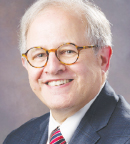JUST 2 MONTHS before Congress passed what to this day is America’s most sweeping anticancer legislation, President Richard Nixon came to Fort Detrick in Frederick, Maryland, to declare his administration’s historic commitment to the fight.
“I have come here today for the purpose of making an announcement with regard to this facility…,” he said. “[W]here we have previously had scientists—some of the best people that we could possibly find in the United States—working on weapons of war, we now have scientists devoting their efforts toward saving life, rather than destroying life.”
An investment of $100 million from the government helped complete the metamorphosis of nearly 70 acres of biowarfare buildings, which, after their transfer from the Army, became a research facility owned by the government but operated on its behalf by a contractor. This peaceful transformation sparked a shared national research facility dedicated to reducing the burden of cancer, HIV/AIDS, and many other threats to the public’s health.

Ethan Dmitrovsky, MD

Douglas R. Lowy, MD

Norman E. Sharpless, MD
A Complicated Picture
THE CONVERTED facility, originally named the Frederick Cancer Research Center, grew—along with our understanding of cancer biology and its complexity. When it was launched nearly 50 years ago, it was thought by some that a cure for cancer could be within reach, if only we would commit adequate resources to the struggle. The picture, we realize today, is decidedly more complicated, but the opportunity to make real progress against cancer and save more lives had never been greater.
We now know cancer to be a constellation of intricate disorders, each with its own distinct biology. Some, like childhood leukemia, are often cured. Others, such as colon and cervical cancers, can even be prevented.
But too many cancers persist as life-threatening illnesses that stubbornly defy our best efforts to treat, let alone cure. To recognize this truth, just spend a day in any cancer clinic. There you will find some of the most daunting problems that patients endure. Challenges of this magnitude are precisely what the federal government decided to confront with a dedicated system of U.S. national laboratories. Of the 19 national laboratories, the Frederick National Laboratory for Cancer Research is the only 1 committed exclusively to the biomedical sciences.
“Of the 19 national laboratories, the Frederick National Laboratory is the only 1 committed exclusively to the biomedical sciences.”— Ethan Dmitrovsky, MD; Douglas R. Lowy, MD; and Norman E. Sharpless, MD
Tweet this quote
Record of Substantial Accomplishments
IN 2012, the facility established under President Nixon’s directive became the latest federal national laboratory. This facility, sponsored by the National Cancer Institute (NCI), has a record of substantial accomplishments upon which to build as a national resource.
In the 1980s, it was instrumental in early work to protect the nation’s blood supply from contamination by the AIDS virus. Subsequently, this laboratory also played a key role in moving to market a new and practice-changing drug for the devastating childhood cancer neuroblastoma (dinutuximab). In recent years, working with the National Institute of Allergy and Infectious Diseases, the laboratory rapidly responded to the Ebola and Zika outbreaks with urgently needed candidate vaccines and clinical trials support.
The Frederick National Laboratory has greatly expanded its scientific portfolio and extended the reach of its advanced technologies and biologic assets, which it shares with other scientists. Its scientific enterprise—guided by external advisory panels and government sponsorship—has become more ambitious, with potentially greater national benefit.
PROGRAMS AND INITIATIVES
The Frederick National Laboratory is involved in a variety of national scientific programs, including:
ATOM: Accelerating Therapeutics for Opportunities in Medicine, a consortium with the mission of transforming drug discovery by accelerating the development of more effective therapies
RAS INITIATIVE: An NCI-led program to explore innovative approaches to attacking the proteins encoded by mutant forms of RAS genes, to ultimately create effective therapies for RAS-related cancers
CANCER MOONSHOT: Program to accelerate cancer research and make more therapies available to more patients, while also improving cancer prevention and early detection
CRYO-EM USER FACILITY: Center dedicated to collecting high-quality cryo–electron microscopy images with minimal delay between request for access and data collection
Yet, we would contend that the Frederick National Laboratory is somewhat of a mystery to cancer scientists and clinicians. Its impressive array of technologies and scientific talent could be a greater part of its discovery arsenal.
Decisive Initiatives
IN ADDITION to the dozens of services it provides—from laboratory animals to clinical trial support to tumor cell lines used across the research community—the laboratory enables decisive initiatives on the forefront of cancer research. Consider just a few:
The Frederick National Laboratory is anchoring a national effort to combat cancers driven by RAS oncoproteins, which contribute to more than 30% of all human cancers, including 95% of pancreatic cancers and 45% of colorectal cancers.1
“[W]e would contend that the Frederick National Laboratory is somewhat of a mystery to cancer scientists and clinicians.”— Ethan Dmitrovsky, MD; Douglas R. Lowy, MD; and Norman E. Sharpless, MD
Tweet this quote
We have known of the impact of RAS for years, but for decades, scientists’ best efforts against RAS-driven cancers have failed. Now, armed with new scientific knowledge, technology, and capability, the Frederick National Laboratory, in coordination with the NCI, has organized an interdisciplinary international team of committed scientists dedicated to changing this trajectory. The RAS Initiative team is striving to target vulnerabilities in RAS proteins and to make available new and powerful tools to explore RAS activity, localization, and signaling. The RAS Initiative also fashioned an open model of collaboration among government, academic, and industry scientists, which reenergized efforts to develop RAS therapeutics.
The Frederick National Laboratory recently built a shared facility to bring advanced imaging science to cancer biology. The National Cryo–Electron Microscopy Facility2 has already served dozens of outside scientific institutions, providing ultra-high–resolution images of proteins in their native states. These images solve structures that could enable new targeted cancer therapies.
With joint support from the Bill and Melinda Gates Foundation and the NCI, the Frederick National Laboratory established a serology laboratory3 that has been authorized by the World Health Organization to establish global standards for measuring the immune response to human papillomavirus (HPV) vaccines, which can prevent cervical cancer and several other cancers. These standards will be used to assist current and new manufacturers in the development of HPV vaccines. Additional production of these life-saving vaccines should help alleviate the current worldwide shortage and reduce the cost of vaccine doses. The first of these vaccines came to market in 2006 as a three-dose regimen, but ongoing research is testing the possibility that a single dose might be sufficient for strong protection. This would be especially useful for protecting those who live in countries where HPV-driven cancers exert a heavy toll and funds for vaccination are scarce.
“The international effort to control cancer will require us to marshal every resource.”— Ethan Dmitrovsky, MD; Douglas R. Lowy, MD; and Norman E. Sharpless, MD
Tweet this quote
The Linchpins of Cancer Research
CLEARLY, THE KNOWLEDGE that biomedical science has accumulated about cancer in the nearly 50 years since the founding of the Frederick National Laboratory is impressive and has pushed novel treatments ever closer to the clinic. Some of these insights have proven humbling as we appreciate that cancer is not one, but hundreds of maladies. The international effort to control cancer will require us to marshal every resource.
The Frederick National Laboratory stands together with cancer survivors, advocates, biomedical industry, foundations, the academy, cancer centers, other national laboratories, and federal agencies studying cancer in the quest to advance science and improve human health. But it stands apart in its method. It tackles problems in ways that cannot be readily addressed by others. And it places new knowledge and solutions derived from its endeavors into the public domain—unique characteristics we believe will be linchpins of cancer research going forward.
"[The Frederick National Laboratory] tackles problems in ways that cannot be readily addressed by others. And it places new knowledge and solutions derived from its endeavors into the public domain….”— Ethan Dmitrovsky, MD; Douglas R. Lowy, MD; and Norman E. Sharpless, MD
Tweet this quote
The Frederick National Laboratory will continue to serve the public’s interests by combating deadly illnesses that touch too many of us and our families—and by helping the research enterprise make the most of every dollar and discovery. We invite you to learn more about the Frederick National Laboratory and how it might serve you. ■
Dr. Dmitrovsky is Laboratory Director of the Frederick National Laboratory for Cancer Research and President of Leidos Biomedical Research, Inc. Dr. Lowy is Deputy Director of the National Cancer Institute. Dr. Sharpless is Director of the National Cancer Institute.
DISCLOSURE: Dr. Dmitrovsky is President of, has patent or intellectual property with, and has received travel/accommodations/expenses from Leidos Biomedical Research. Dr. Lowy receives a limited share of royalties through the National Institutes of Health and National Cancer Institute for technologies licensed to Merck, GlaxoSmithKline, Indian Immunologicals Ltd, Shanta Biotech, Pax Vax, and Acambis Inc. Dr. Sharpless was employed by and had a leadership role in GI Therapeutics and Healthspan Diagnostics; owned stock or other ownership interest (divested in September of 2017); was a consultant for GI Therapeutics, Healthspan Diagnostics, and Unity Biotechnology; had patent or intellecutal property interest in Unity Botechnology (relinquished patents in September 2017).
REFERENCES
1. Frederick National Laboratory for Cancer Research: Cancer Research Technology Program. Available at https://frederick.cancer.gov/science/cancer-research-technology-program. Accessed February 8, 2019.
2. Frederick National Laboratory for Cancer Research: National Cryo-Electron Microscopy Facility. Available at https://frederick.cancer.gov/science/technology/national-cryo-em-facility. Accessed February 8, 2019.
3. Frederick National Laboratory for Cancer Research: HPV Serology Laboratory. Available at https://frederick.cancer.gov/science/hpvserologylab/overview. Accessed February 8, 2019.

